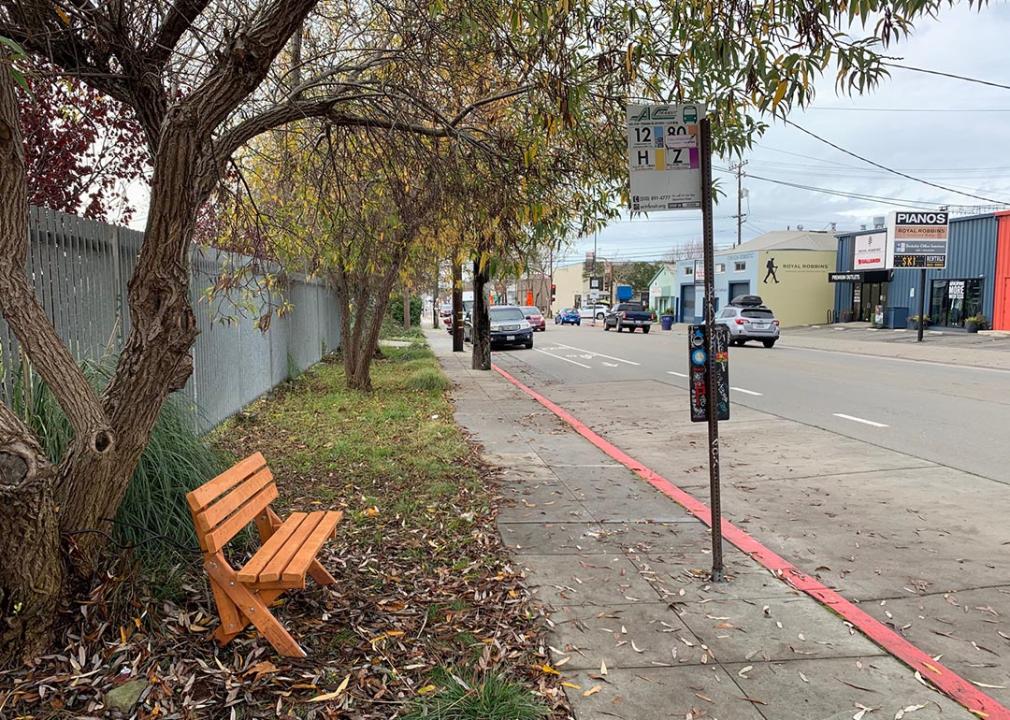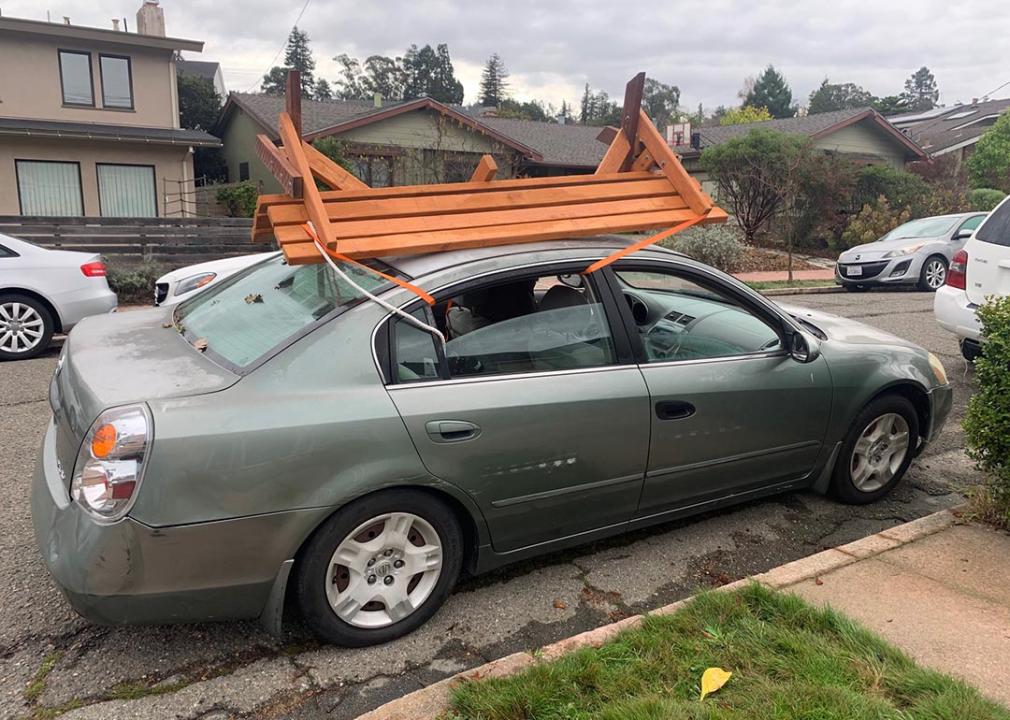
By day, Mingwei Samuel works as a software developer. Also by day — together with urbanist and writer Darrell Owens — he builds and installs benches at bus stops around the California cities of Berkeley and Oakland that have no seating.
It's a tale as old as social media: In November, Owens tweeted a photo of his 64-year-old neighbor sitting on the curb at a bus stop to draw attention to the lack of seating for bus riders.
"Which stop?" replied Samuel. "I can put a bench there."
A month later, he had placed a wooden bench, built based on a template from the Public Bench Project, at the bus stop in downtown Berkeley. The response — from the city and from bench enthusiasts around the world — was immediate. On Dec. 17, he installed the bench; by Dec. 28, Berkeley had removed the bench and replaced it with an official metal one.
"I was expecting a positive reaction, but I wasn't expecting how big the tweet would get and how much attention that would get on local news as well," Samuel tells Next City.
More importantly, Owens' neighbor – who has chronic pain and has trouble standing for long periods of time – doesn't have to sit on the curb at the bus stop anymore. "What can I say, it blew me away," he told Berkeleyside. "Now that I can have a place to sit, that's awesome."
After that first bench, Samuel and Owens teamed up to build and place even more benches at bus stops. As of mid-January, more than six have been placed, with more in the works. "No one's really asked Darrell and I to stop," says Samuel.
In fact, the City of Berkeley is mobilizing to bring more benches to more bus stops, according to former councilmember Kate Harrison. "I think it's lovely," says Harrison, who resigned in late January while calling out the city's "broken" processes and failure to adequately address residents' concerns. "I like this as a statement of public need. People are expressing what they really need to make riding transit effective."

As thrilling as guerilla bus benches can be, everyone Next City spoke to agreed that this is a job for the public sector. The city or transit agency should step up and provide seating at bus stops for all riders, they say.
"I think if we treated bus riding with the same sort of essential attitude as we treat car driving, then we'd definitely see better benches, better shelters at all the bus stops," says Samuel.
Of the 512 bus stops in Berkeley, 50 of those have a bus shelter, meaning that 90% of stops have no shelter and no attached bench. It's unclear if there is a separate list for stops with only a bench.
Historically, bus riders are not prioritized in the transportation system. "Train riders tend to be higher income," explains Mary Buchanan, research and policy manager at the TransitCenter foundation. "There tend to be more white train riders than white bus riders."
Bus stops are often a snarl of bureaucratic dysfunction with multiple agencies and departments working within the public right-of-way. While the transit agency might decide where bus stops are placed, they usually have no jurisdictional authority to place a shelter or bench on the sidewalk, which is controlled by the city. Predictably, this leads to a lot of blame-shifting.
"[C]ities in our service areas maintain authority over their streets and sidewalks, including the placement of outdoor furniture," AC Transit spokesperson Robert Lyles told Next City in response to a question about the agency's role in adding bus benches. The city of Berkeley did not respond to a request for an interview.
"Transit riders — they don't know or care, nor should they, which entity is responsible for providing this resource," says Buchanan.
It is possible for a transit agency to provide better amenities for bus riders. One example is TriMet in Portland, Oregon. To streamline the process of adding bus shelters, the agency took over shelter siting and installation within its service area, leveraging its knowledge of the entire system and cutting through red tape. "Leave the bus riders out of it. Leave advocates out of it. Stop pointing fingers," Buchanan says.
While there are no signs that AC Transit intends to take over the bus stops in Berkeley or any other city, emails provided to Next City by Harrison show that the agency is collaborating with the city to determine where new bus benches should go.
In 2022, then-mayor of Emeryville John Bauters made bus bench history when he spearheaded an effort to rapidly install seating at all bus stops in the city. Seven months and 50 quick-build "Simme-Seats" later, every bus stop without seating got a bench.
Since then, Bauters says that transit advocates across California have sought to emulate the Emeryville model.
"I just always lead with safety and accessibility," says Bauters of his messaging strategy. Now a city councilmember, he has taken an assertive and outspoken approach to improving streets and sidewalks. "If it's not safe or accessible to everybody, it's not equitable."
One difference: The city installed benches without engaging in a lengthy community engagement process. In other cities, NIMBYism has often blocked basic amenities for transit riders like bus shelters and benches. The key, Bauters says, is to prioritize the city's values — in this case, safety and equity — and to ask the right questions.
"When it comes to infrastructure, [cities] go out and they go, 'Do you like this?' And there's a lot of people who unsurprisingly, say, 'No, I don't want the bike lane. No, I don't want the bus bench in front of my house, a homeless person will sleep on it.'"
It's also important for cities to limit the number of departments and entities involved in the process, adds Buchanan. She named the city of Los Angeles, notorious for requiring eight different agencies and a 16-step approval process to install a single bus shelter.
According to Harrison, there will be no appeal process for bus benches. "We will look at need and where there's a lot of riders, and that's where the benches are gonna go."
She told Next City she planned to propose a bus bench pilot program similar to what the city of Hayward, California, is doing, as there is no process currently. (It's unclear if any such proposal will move forward since her resignation.)
Inspired by Emeryville, Hayward is piloting quick-build bus benches at ten stops to study the effects on rider behavior. A staff report puts the cost of one Simme-Seat at $2,000, estimating that it would cost an estimated $600,000 to put seats at all 300 bus stops with no bench.
"It seems kind of silly to me to waste all the time and money collecting data on something we know just needs to be done," says Bauters.
Harrison hopes to use funds from a 50-cent ride-hailing sales tax that is set to generate an estimated $1 million in 2024. AC Transit already has a list of bus stops ranked by equity criteria and seven outstanding requests for benches.
In the meantime, guerilla bus benches will continue to pop up in the East Bay. And Samuel wants people to know that the benches have improved since the first one he placed in downtown Berkeley.
"We added cross bracing. We replaced the legs with treated wood so it should last longer … a lot of thought has gone into making these benches safe and durable for the real world, even though they aren't official."
This story was produced through the Equitable Cities Fellowship for Social Impact Design, which is made possible with funding from the National Endowment for the Arts.
This story was produced by Next City, a nonprofit newsroom covering solutions for equitable cities, and reviewed and distributed by Stacker Media.